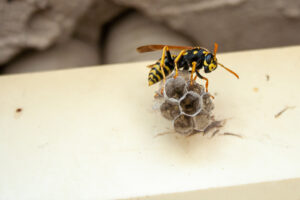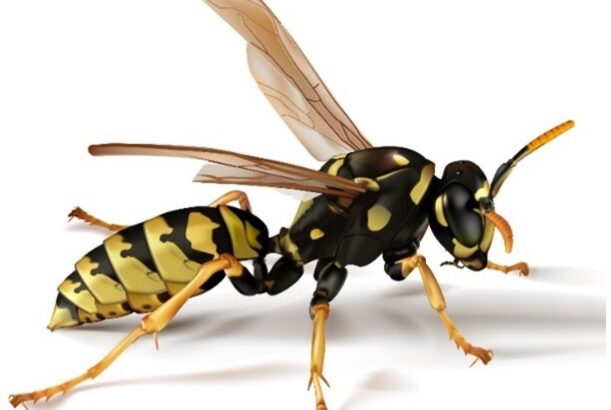What's the Buzz on Stinging Insects
Stinging insects including hornets, wasps and yellowjackets are as much a part of our environment as trees, flowers and grass. And while some stinging insects are beneficial to our environment, others prove to be a nuisance for your employees, guests and customers.
With temperatures on the rise and outdoor activities including dining and entertainment as well as job duties that take employees outside, the chance of encountering stinging insects is more likely.

“Like other pests including rodents and flies, stinging insects are attracted to certain commercial properties because of the food sources that are present,” says Edna Alfaro Inocente, a regional entomologist with Sprague Pest Solutions based in Denver.
Food and beverage processing plants are particularly attractive due to the sugary composition of the items produced there. Inocente says odors produced during the fermentation process at a brewery can attract stinging insects as does spillage of liquid products like beer or milk during the loading or unloading process.
The Stinging Insect Threat
Why do commercial property owners and managers need to be concerned about the presence of stinging insects? The chief concern is allergic reactions to being stung. According to the National Pest Management Association, stinging insects send more than 500,000 people to the emergency room each year due to allergic reactions after being stung.
In addition to the health hazards associated with allergic reactions to being stung, the presence of stinging insect nests hanging from the outside of a structure can be unsettling to customers, guests and employees, according to Inocente.
What stinging insects are encountered most frequently around commercial facilities? The list includes yellow jackets, paper wasps, honeybees, carpenter bees, and bald-faced hornets.
Yellowjackets nests can be home to thousands of residents and continue their life cycle well into the late autumn. They will harass customers, guests and employees at outdoor eateries, theme parks, congregate at bakeries, breweries, candy factories and meat packing plants, seek out spilled sodas at sporting stadiums and fast-food restaurants. Their scavenger behavior puts them into interaction with humans which increases the potential for sting incidents
Paper wasps are often mistakenly called yellowjackets. These wasps are much longer in body and have a very thin “wasp-like” waist. They make nests under the eaves of structures, branches of trees and shrubs, porch ceilings, the tops of window and doorframes, soffits, eaves, attic rafters, deck floor joists and railings.
Bald faced hornets are an aggressive insect that although considered a hornet because of its large size and aerial nest, is more closely related to the yellowjacket group. They are often found in tree hollows and on dense shrubs and trees. They are protective of their nests and will aggressively attack and sting people and animals they deem a threat.
Africanized Honeybee – The Africanized bee is a hybrid species of the Western honeybee and has established itself in many parts of California, southern Nevada and Arizona. They can be dangerous stinging insects that have been known to chase people for more than a quarter of a mile once they get excited and aggressive.
Where Stinging Insects Live
Stinging insects will establish nests in a variety of locations in and around commercial properties both above and below ground. Don’t assume they will establish their nests in visible locations under eaves, overhangs or trees. Stinging insect nests can also be in wall voids, inside old equipment and outdoor electrical boxes. When looking for the source of a stinging insect issue it is important to take a 360-degree view of your property. Commercial property maintenance staff should not attempt to remove a nest without the assistance of a licensed and trained professional.
Common locations where stinging insect nests can be located include:
- Trees and bushes
- Building corners, eaves and overhangs
- Inside attics and beams and supports in warehouses, barns or open-air facilities
- Gutters and poles
- Garbage and recycling dumpsters
- Inside exterior wall voids
- Loading docks
- In the hollows of playground equipment at schools, daycare facilities and parks
- Outdoor dining and food service areas including under furniture
Tips To Reduce Stinging Insects
To reduce the stinging insect threat in and around commercial properties Sprague’s Inocente offers the following recommendations:
- Reduce Spillage – Clean up spillage in loading and unloading areas. Don’t let liquid residue to remain as it will attract stinging insects and other undesirable pests including flies, cockroaches and rodents. Double-bag garbage and trash, and seal it tightly to prevent it from ripping and leaking.
- Clean Dumpsters – A clean, washed dumpster won’t be enough to keep stinging insects from foraging if there are spills in the surrounding areas, including the dumpster pad. It is equally important to keep the area between the back door and the dumpster clean.
- Empty the Trash – Exterior trash containers should be emptied frequently – daily at least – during warm weather. Stinging insects will scout for food in the morning, so make sure there is nothing to attract them.
- Exclusion – Seal cracks and crevices to prevent stinging insects from gaining access to wall voids inside a building. Install properly fitting screens on windows and ventilation openings. Remind employees to keep exterior doors closed when not in use and establish a positive airflow around loading dock doors to deny stinging insects access.
- Inspect Your Property. Keep an eye out for nests on the property. Early detection helps prevent nests from becoming large and aggressive.
Discover The Sprague Difference
For more information on how Sprague Pest Solutions can assist you establish an effective stinging insect prevention or management program, call 855.805.0755.

